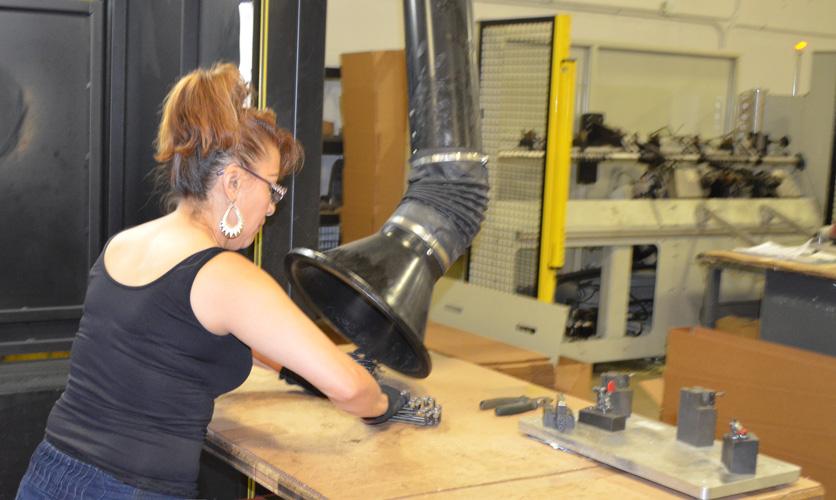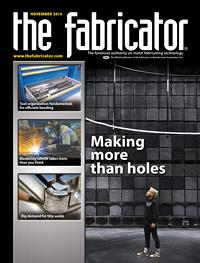Editor-in-Chief
- FMA
- The Fabricator
- FABTECH
- Canadian Metalworking
Categories
- Additive Manufacturing
- Aluminum Welding
- Arc Welding
- Assembly and Joining
- Automation and Robotics
- Bending and Forming
- Consumables
- Cutting and Weld Prep
- Electric Vehicles
- En Español
- Finishing
- Hydroforming
- Laser Cutting
- Laser Welding
- Machining
- Manufacturing Software
- Materials Handling
- Metals/Materials
- Oxyfuel Cutting
- Plasma Cutting
- Power Tools
- Punching and Other Holemaking
- Roll Forming
- Safety
- Sawing
- Shearing
- Shop Management
- Testing and Measuring
- Tube and Pipe Fabrication
- Tube and Pipe Production
- Waterjet Cutting
Industry Directory
Webcasts
Podcasts
FAB 40
Advertise
Subscribe
Account Login
Search
The bright side of proper fume extraction
Fabricator clears the air after capping its robotic welding cells
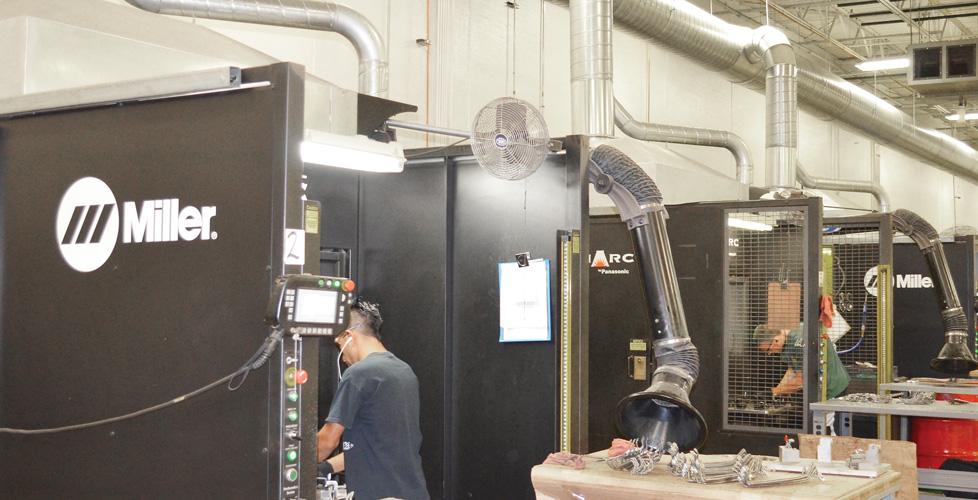
Figure 1
These four robotic welding cells produce thousands of wire-form assemblies for the automotive industry each year. The hoods that cap each individual cell keep the surrounding atmosphere clear of welding fumes.
A little more than two years ago, All-Rite Industries took a major step when it almost doubled its manufacturing square footage by acquiring the building next to its original Lake Zurich, Ill., location. This was a new era of production for the high-volume manufacturer of wire-form parts, stampings, and injection-molded parts.
The additional 45,000 sq. ft. of manufacturing space gave the company much more elbow room for its expanding robotic welding activities (see Figure 1), which took up about a quarter of the new floor space. A new welding cell with a robotic welding arm, accompanying wire-feeding equipment, and a rotary table were added to the other three similar cells around the time of this expansion.
The company installed new lighting and painted all of the walls a bright white. This new facility was going to be a showcase for potential customers.
That changed, however, as the robotic welding cells went to work two shifts every workday. The fume collection system that had covered not only welding but also some stress relieving in the old building couldn’t keep up with all of the added welding operations.
The Growth of Robotic Welding
All-Rite’s evolution into a supplier of wire forms is somewhat recent, especially considering the company was founded in 1947. (It is currently owned and operated by Ed Bilik.) Prior to entering the world of robotic gas metal arc welding it finds itself inhabiting today, All-Rite was and still is a supplier of more than 2 million metal and plastic parts to a variety of industries, particularly the automotive industry. The company is a direct supplier to Ford and a number of Tier 1 and 2 automotive suppliers.
The fabricator had outsourced its welding in the early 2000s, but when its supplier increased its prices 30 percent, All-Rite decided to investigate bringing the process in-house. While All-Rite leaned on another source for the welded products, the management team began researching robotic welding offerings.
They chose a used PerformArc from Panasonic Factory Solutions, now a part of Miller Electric, and sent a tool engineer to be trained on how to set up and run the cell. The tool engineer then was charged with training the operators at All-Rite.
“We’ve been chasing that robotic welding business ever since,” said Mark Andreasik, All-Rite’s general manager.
Three years after the purchase of the first cell, All-Rite purchased its first new PerformArc. Three years later, it added another, similar cell.
During this time, a centralized fume collection system in the original building was adequate for the company’s ventilation needs. Interest in the fabricator’s automated welding services, however, kept growing.
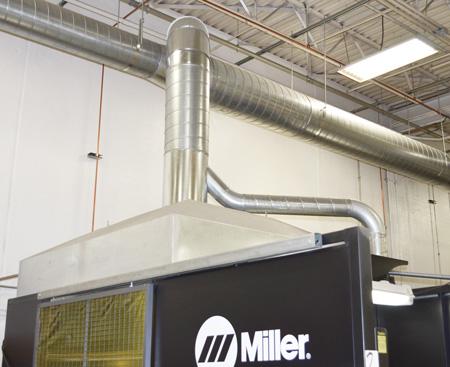
Figure 2
Because all of the robotic welding cells were alike, the duct-work went quickly since all of the vent hoods were of the same size and configuration.
By the time it made the move to the new building—and with the addition of its latest robotic welding cell—All-Rite was burning through approximately 1,600 lbs. of wire per month. The cells were in constant use every day because the rotary tables and nimble operators fed wire forms to the welding robot on a steady basis.
“We are welding brackets and the weld is about an inch long, so you aren’t putting a ton of wire on there,” Plant Manager Tony Baldassone explained. “Some require welds on both sides. Some require two brackets.”
But the welding was almost nonstop, and the centralized fume collection system that worked in the old building couldn’t keep up with the extraction chores in the new building.
“What happened is very, very common,” said Charles Bown, Filtration Systems, a representative for United Air Specialists Inc. (UAS), an air filtration and pollution control equipment manufacturer. All-Rite pushed the limits of the older fume extraction setup and then exceeded the original specifications for the equipment. As a result, it needed a new approach.
Putting a Cap on the Situation
Bown had worked with the company when it installed the original fume collection system, and All-Rite went to him for assistance again. When Bown saw the four identical cells sitting side by side, he knew they were in an ideal place to cap (see Figure 2) and then duct the fumes through a central filtration system outside (see Figure 3).
One of the big decisions was where UAS’s SFC downward flow cartridge dust collection system would be placed. The easy answer was to put it on the side of the building, just on the other side of the wall from the robotic welding cells. But the company’s management team didn’t want the equipment to be visible to the hundreds of passersby on the busy thoroughfare in front of the facility. So they decided to run the ductwork for the collection system 130 feet toward the rear of the building.
All-Rite also added extraction arms on the sides of the cells. That way the vents could be placed over still-smoking red-hot parts removed from the rotary table (see Figure 4).
Baldassone said the entire installation process took a little over two weeks. The welding department was able to work around the installation effort with the exception of shutting down a cell for one workday while the vent hoods were put on each individual cell.
“When you walk into the building now, you can see a night and day difference,” Baldassone said.
“The employees are very happy,” Andreasik added.
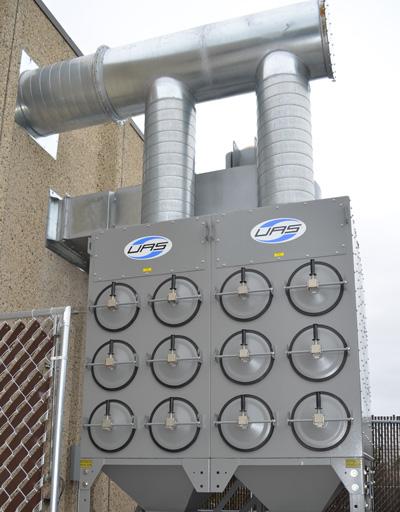
Figure 3
All-Rite’s filtration system uses cartridge-style filters that feature nanofiber technology to capture fume particulate on the surface of the filter. The clean air that normally would be discharged into the atmosphere actually can be fed back into the facility—with a simple adjustment of the damper—during the winter months to help heat the building.
From Factory Floor to Showplace
The dungeon look is now gone, and All-Rite’s new building sparkles again. Customers visit frequently, and they are impressed with the overall look of a modern, clean manufacturing environment.
“This definitely works for us,” Andreasik said.
“Now that we have the technology, the capacity, and the expertise, we are pursuing more business with our existing customer base,” he added.
That might mean more automated welding cells—and the filtration requirements that go along with them.
The Maintenance Side of Things
Charles Bown of Filtration Systems estimated that the lifetime of the approximately 13-in.-diameter, 26-in.-long filters in All-Rite Industries’ new particulate collection system might be up to three years.
“It depends on how much they are using the system,” he said.
The United Air Specialists (UAS) ProTura® nanofiber filters have a surface comprised of tiny web-like layers of fiber that trap particulate on the filter surface, preventing it from getting embedded in the media. This is important because the particulate is then easier to remove during automated pulse cleaning of the filters.
The SFC filtration equipment also has a patented pulse cleaning system. Relying on a specialized nozzle and venturi design, the system pulses compressed air at a precisely calculated distance through an unobstructed airway. This action cleans material from the filter surface along the entire length of the cartridge.
UAS officials believe that this design results in fewer pulse cycles when compared to typical cartridge-style systems. Fewer pulse cleanings reduce the stress that is inflicted on the filter media, helping the filters to last longer. Also, because fewer pulse cycles are conducted, the system does not consume as much compressed air as might be expected, leading to operational savings.
When operational gauges indicate the filters need to be changed, a maintenance technician only needs to flip a handle, opening the door and gaining access to the filter cartridge. The cartridge slides out and can be replaced without tools.
About the Author

Dan Davis
2135 Point Blvd.
Elgin, IL 60123
815-227-8281
Dan Davis is editor-in-chief of The Fabricator, the industry's most widely circulated metal fabricating magazine, and its sister publications, The Tube & Pipe Journal and The Welder. He has been with the publications since April 2002.
Related Companies
subscribe now

The Fabricator is North America's leading magazine for the metal forming and fabricating industry. The magazine delivers the news, technical articles, and case histories that enable fabricators to do their jobs more efficiently. The Fabricator has served the industry since 1970.
start your free subscription- Stay connected from anywhere

Easily access valuable industry resources now with full access to the digital edition of The Fabricator.

Easily access valuable industry resources now with full access to the digital edition of The Welder.

Easily access valuable industry resources now with full access to the digital edition of The Tube and Pipe Journal.
- Podcasting
- Podcast:
- The Fabricator Podcast
- Published:
- 04/16/2024
- Running Time:
- 63:29
In this episode of The Fabricator Podcast, Caleb Chamberlain, co-founder and CEO of OSH Cut, discusses his company’s...
- Trending Articles
How to set a press brake backgauge manually

Capturing, recording equipment inspection data for FMEA

Tips for creating sheet metal tubes with perforations

Are two heads better than one in fiber laser cutting?

Hypertherm Associates implements Rapyuta Robotics AMRs in warehouse

- Industry Events
16th Annual Safety Conference
- April 30 - May 1, 2024
- Elgin,
Pipe and Tube Conference
- May 21 - 22, 2024
- Omaha, NE
World-Class Roll Forming Workshop
- June 5 - 6, 2024
- Louisville, KY
Advanced Laser Application Workshop
- June 25 - 27, 2024
- Novi, MI
























